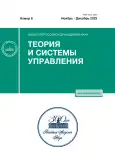Game-Theoretic Specificity of a Competitive Allocation of the Frequency Spectrum
- 作者: Kaplan V.S.1, Novikova N.M.2, Pospelova I.I.1
-
隶属关系:
- Faculty of Computational Mathematics and Cybernetics, Moscow State University, 119991, Moscow, Russia
- Federal Research Center “Computer Science and Control,” Russian Academy of Sciences, 119333, Moscow, Russia
- 期: 编号 6 (2023)
- 页面: 124-136
- 栏目: SYSTEM ANALYSIS AND OPERATIONS RESEARCH
- URL: https://journals.rcsi.science/0002-3388/article/view/148146
- DOI: https://doi.org/10.31857/S0002338823060057
- EDN: https://elibrary.ru/GQEKGT
- ID: 148146
如何引用文章
全文:
详细
We consider the problem of developing and optimizing the rules of the spectrum auction. One-sided sealed-bid spectrum auctions are studied. Two types of pricing are compared theoretically: the first-price and the second-price. А game model of the auction with free riders is constructed. A free rider uses frequencies purchased by another such participant for free. All Nash equilibria of the obtained games are found and represented in an analytical form. The significant difference between games with all free riders and games with at least one ordinary player is shown. It is proved that when players eliminate their dominated strategies, the resulting auction price of the lot is determined by its value for ordinary players. In the case when all players are free riders, the price is equal to the minimal bid price. The influence of the information the participants have about their partners’ values of a lot on the outcome of the game is discussed. The theoretically obtained properties are in agreement with the results of the experiments presented for spectrum auctions in the scientific literature.
作者简介
V. Kaplan
Faculty of Computational Mathematics and Cybernetics, Moscow State University, 119991, Moscow, Russia
Email: ipospelova05@yandex.ru
Россия, Москва
N. Novikova
Federal Research Center “Computer Science and Control,” Russian Academy of Sciences, 119333, Moscow, Russia
Email: novikova@gse.cs.msu.ru
Россия, Москва
I. Pospelova
Faculty of Computational Mathematics and Cybernetics, Moscow State University, 119991, Moscow, Russia
编辑信件的主要联系方式.
Email: ipospelova05@yandex.ru
Россия, Москва
参考
- Jackson M. Mechanism Theory // Optimization and Operations Research / Ed. U. Derigs. V. 3. Oxford: EOLSS Publishers, 2003.
- Давидсон М.Р., Догадушкина Ю.В., Крейнес Е.М., Новикова Н.М., Селезнев А.В., Удальцов Ю.А., Ширяева Л.В. Математическая модель управления энергосистемой в условиях конкурентного оптового рынка электроэнергии и мощности в России // Изв. РАН. ТиСУ. 2009. № 2. С. 84–94.
- Васин А.А. Математические модели рынков и аукционов. М.: МАКС Пресс, 2023.
- Сонин К.И. Основы теории аукционов (Нобелевская премия по экономике 2020 года) // Вопросы экономики. 2021. № 1. С. 5–32.
- Handbook of Spectrum Auction Design / Eds M. Bichler, J. Goeree. Cambridge: Cambridge University Press, 2017.
- Hu S., Shi R. Analysis of Recent Development of Spectrum Auction and Forecast of Future Development // 3rd Intern. Conf. on Economic Management and Cultural Industry. V. 203. Guangzhou: Atlantis Press, 2021. P. 518–522.
- Dong X., Zhang Y., Guo Y., Gong Y., Shen Y., Ma J. PRAM: a Practical Sybil-Proof Auction Mechanism for Dynamic Spectrum Access with Untruthful Attackers // IEEE Transactions on Mobile Computing. 2021. V. 22. P. 1143–1156.
- Devi M., Sarma N., Deka S. K. Multi-Winner Spectrum Allocation in Cognitive Radio Networks: A Single-Sided Auction Theoretic Modelling Approach with Sequential Bidding // Electronics. 2021. V. 10. P. 602–626.
- Dang Y., Li Z. The Analysis and Discussion of Spectrum Auctions Based on Case Study // J. Education, Humanities and Social Sciences. 2022. V. 2. P. 181–185.
- Bykowsky M.M., Olson M., Sharkey W.W. Efficiency Gains From Using a Market Approach to Spectrum Management // Information Economics and Policy. 2010. V. 22. P. 73–90.
- Sharkey W.W., Beltran F., Bykowsky M.M. Comparing the Ability of Different Auction Mechanisms to Efficiently Designate Spectrum Between Licensed and Unlicensed Use // SSRN Electronic Journal. 2013. http://ssrn.com/abstract=2214022. https://doi.org/10.2139/ssrn.2214022.
- Каплан В.С. Специфика и теоретико-игровой анализ аукциона размещения частот // Тихоновские чтения. Научная конференция: тез. докл. М.: МАКС Пресс, 2022. С. 85.
- Гермейер Ю.Б. Введение в теорию исследования операций. М.: Наука, 1971.
- Васин А.А., Краснощеков П.С., Морозов В.В. Исследование операций. М.: Академия, 2008.
- Мулен Э. Теория игр с примерами из математической экономики. М.: Мир, 1985.
- Vickrey W. Counterspeculation, Auctions, and Competitive Sealed Tenders // Journal of Finance. 1961. V. 16. No. 1. P. 8–37. https://doi.org/10.1111/j.1540-6261.1961.tb02789.x
- Fookes N., McKenzie S. Impact of Budget Constraints on the Efficiency of Multi-lot Spectrum Auctions // Handbook of Spectrum Auction Design. Eds M. Bichler, J. Goeree. Cambridge: Cambridge University Press, 2017. P. 764–781.
- Edelman B., Ostrovsky M., Schwarz M. Internet Advertising and the Generalized Second-price Auction: Selling Billions of Dollars Worth of Keywords // American Economic Review. 2007. V. 97. No. 1. P. 242–259. https://doi.org/10.1257/aer.97.1.242
- Weber R.J. Making More from Less: Strategic Demand Reduction in the FCC Spectrum Auctions // J. Economics and Management Strategy. 1997. V. 6. No. 3. P. 529–548.
- Cramton P., Schwartz J.A. Collusive Bidding: Lessons from the FCC Spectrum Auctions // J. Regulatory Economics. 2000. V. 17. P. 229–252.
- Milgrom P., Segal I. Designing the US Incentive Auction // Handbook of Spectrum Auction Design. Eds M. Bichler, J. Goeree. Cambridge: Cambridge University Press, 2017. P. 803–815.
- Nash J.F. Non Cooperative Games // Annals of Math. 1951. V. 54. No. 2. P. 286–295.
- Maskin E. Mechanism Design for Pandemics // Review of Economic Design. 2022. V. 26. No. 3. P. 255–259.
补充文件









